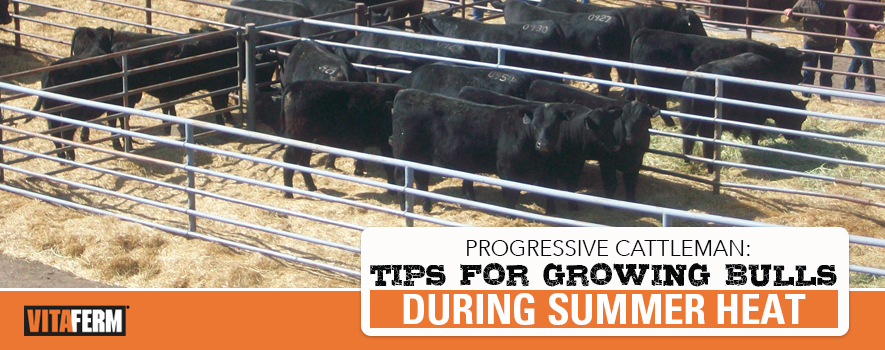Oil and water. Cats and dogs. Bull fertility and summer heat. All of these are things that don’t necessarily mesh. When it comes to reproductive performance of your herd, you work hard to make sure your cows are in an ideal body condition and are reproductively sound; however, the bull’s reproductive health and condition also needs to be considered.
The summer months can be the most challenging time to keep, maintain and develop bulls due to the excessive temperatures. It doesn’t matter if you are maintaining your bulls over the summer until the next breeding season or growing and developing young bulls, the high temperatures can play havoc on reproductive performance in your sires.
Heat causes stress, and anytime stress exists, spermatogenesis (production of sperm) and sperm quality are negatively impacted. In addition to the quality and quantity of sperm being reduced, sperm motility, concentration and total number of sperm per ejaculate are all negatively affected. In addition to sperm production, heat stress can cause a lack of libido in bulls.
The negative effects on semen quality are not usually realized for 45 to 60 days after the stress occurs since the testes and tubules store an abundant amount of sperm. That is why it is always important to have a thorough breeding soundness exam 30-60 days before turning out bulls with cows.
Mark Rohr, owner of the Lazy H Ranch and Proven Sire Services at Hays, Kan., raises and markets between 140-180 bulls each year, starting with his March sale through the fall turn-out in October. The mix of predominantly Angus bulls, with about 25% Charolais bulls, are born and raised on the ranch on the Kansas prairie. He currently has about 100 fall-born bulls that were weaned this spring on test and is developing those for his next sale. Over time, he said he has discovered the keys to growing structurally sound and fertile bulls that will work for his customers are to take it slow and to provide them a high-quality mineral program.
“The slower we grow these older cattle in the summer months, the more increases in fertility and longevity in these older bulls, along with the fact that they still get to travel in the grass paddocks while they are still on a supplement ration,” Rohr said. “The feed ration that they are on doesn’t include any silage. It isn’t an extremely powerful feed source. We aren’t adding any water, which allows their rumen and their digestive system to break down that feed on their own.”
Rohr weans his fall-born calves in April, putting them in a receiving pen to get them acclimated to the feed bunk. As they are weaned, they receive a dose of Vita Charge® Cattle Drench to help jump start their feed and water intake. As part of the Vita Charge Weaning Program, he also makes sure they have access to the Vita Charge Stress Tubs. All VitaFerm and Vita Charge products contain Amaferm®, a precision-based prebiotic designed to impact intake, feed digestibility and nutrient absorption to help combat stress and jump start feed intake.
Rohr starts his bulls on a ground cane mix and a supplement ration that is 65% corn and 35% distiller’s grain with VitaFerm Concept•Aid® pellets fed at 2 oz./head intake. The pens have free-standing bunks as well as fence line bunks they will convert to as they get used to eating from the bunk. And one thing Rohr is very particular about is the free-flowing cold water that is always available to them.
“The bulls get fresh, rural water from an automatic water. That to me is the key, because that water is always cold,” he said.
Typically, around July 1, the bulls will begin their 90-100-day bull test, where they are gaining and growing through the bulk of the summer heat. At this time, they remain on the grass paddocks, where they have been since weaning and where they have room to move, graze and continue on their ration. All bulls are weighed on the first day of the test and given another dose of Vita Charge Drench. The fine, loose rock salt is removed from the pens, and VitaFerm HEAT® mineral with plant extracts to maintain body temperature is added to the far end of the run. The bulls still have access to the Stress Tubs, and still get the Concept•Aid in their ration. Rohr starts all bulls on the corn/distiller’s ration at one percent of their bodyweight, and by the end of the test, the bulls are eating 1.5% of their body weight.
“Our bulls are on a slow grow ration based on 2.5-pounds of gain, but we usually exceed 3 pounds per day pretty easily,” Rohr said, attributing the added digestion and absorption to the Amaferm they are consuming.
He also credits his mineral program for the exceptional fertility he’s experienced when it comes time to semen test his bulls each January. Prior to using the VitaFerm products, he said he’d have 2-3% of his bulls fail a semen test. In 2018, only two bulls out of 110 didn’t pass. Earlier this year, with 125 bulls in the sale, he had 100% of them pass.
“I am in partnership on another set of bulls on feed at another location, under different management but the same mineral program, using a different vet service, we had 100% semen check there, and that vet wanted to know what we do to make that happen. As far as fertility in our bulls, the VitaFerm mineral and Amaferm advantage has been awesome,” Rohr said.
In a time where cattle producers are looking to cut costs, Rohr said the one cost he won’t cut is his mineral program, and he encourages his bull customers to continue the same program for continued positive results.
“We don’t need to cut this mineral program out of our budget right now. Our customers are also using it and they believe in it too,” he said.
Fertility in your bull battery is critical, and reproductive success starts with a high-quality mineral program.



